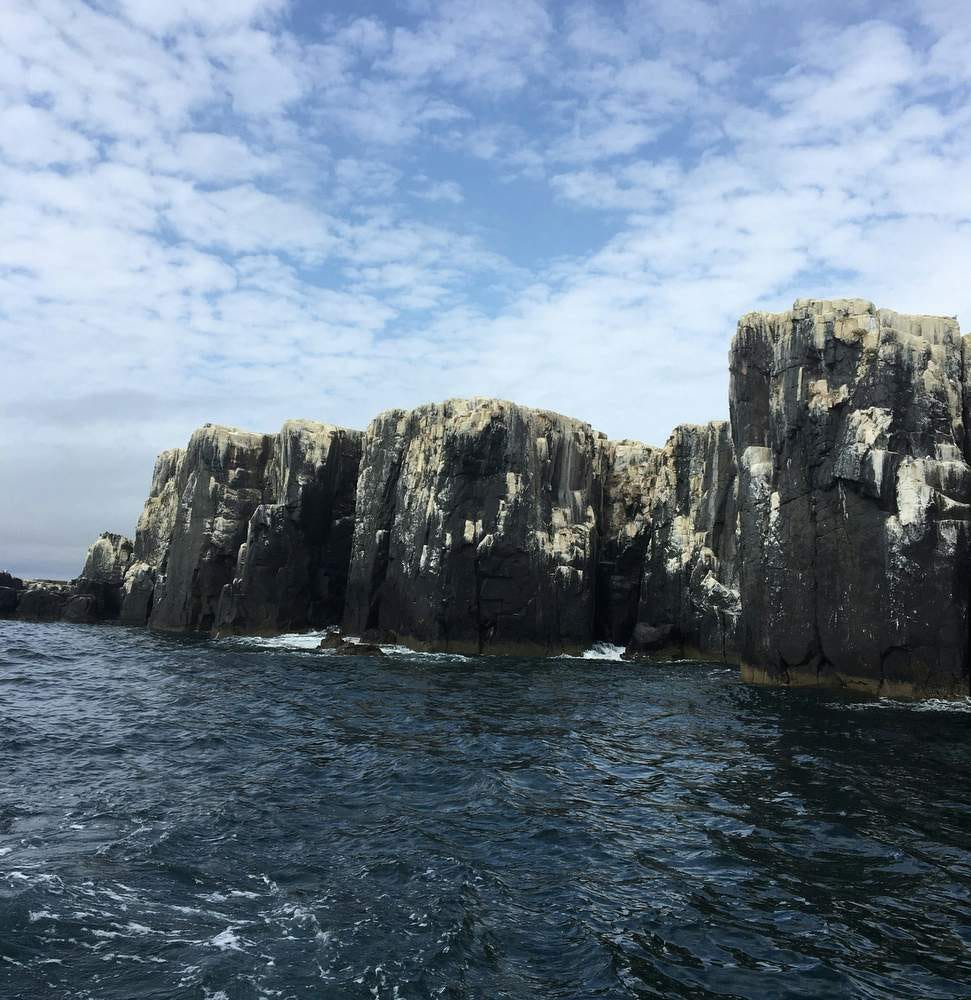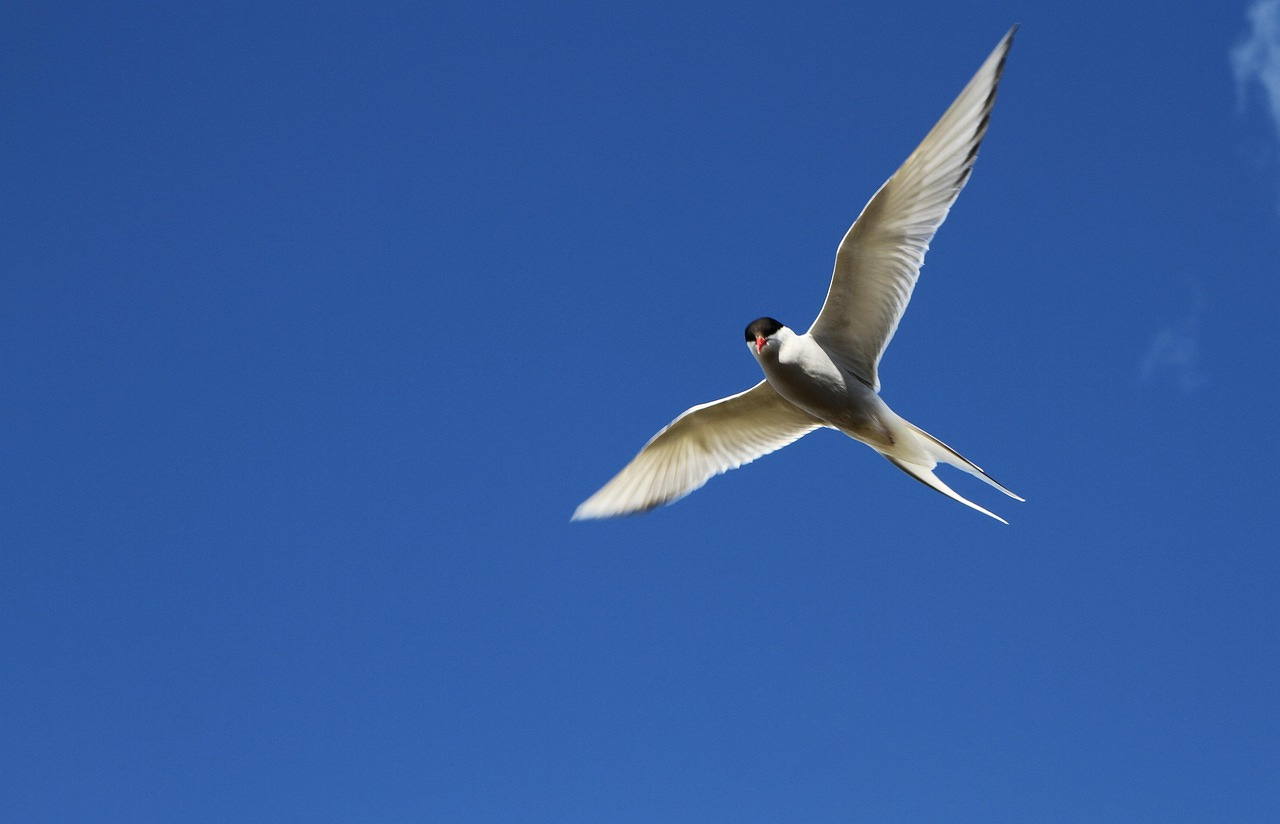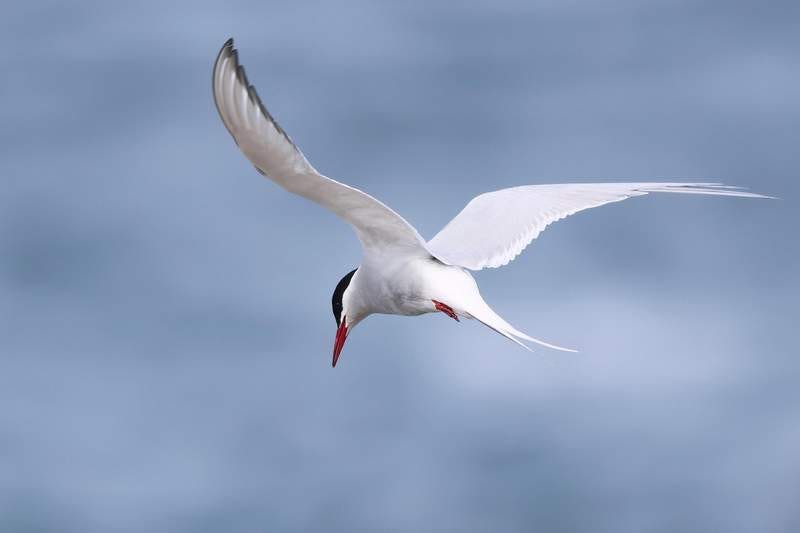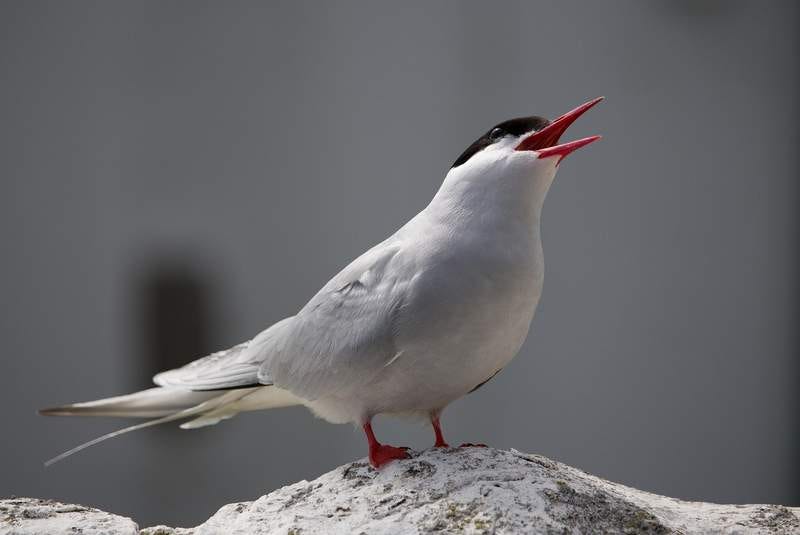Hello! Welcome to Everything Is Amazing, a newsletter about science and wonder.
This season we’re looking at the world of air above our heads that’s anything but “empty” - but when I wrote about the microbial life found clinging to the upper reaches of the stratosphere, I assumed that must be the most impressive example I could find of life making a long-term home for itself in our skies.
Today, I’m delighted to explain to you how wrong I was.
It’s 2016, and biologist Richard Bevan is making an incredible discovery.
With colleagues from Newcastle University, he’s analysing a series of tiny devices recovered from the legs of a particular breed of bird from Northumberland’s Farne Islands, just off the English coast by Bamburgh Castle.
These machines are tiny geolocators, weighing just 0.7 grams, and designed to record any daylight reaching their sensors every 5 minutes. This is enough to track the passage of sunrises and sunsets and how much daylight the bird is experiencing over long periods of time.
With this information, researchers can deduce each bird’s latitude and rough location. Each geolocator has tracked the migratory movements of each bird over the last year, ending when it returned to the Farne Islands for the slightly warmer-rained period of mostly random weather we English laughingly refer to as ‘summer’.
The birds under study are Arctic terns, and the specimen whose geolocator Bevan is studying is believed to be female from its size and shape (it’s surprisingly tricky to identify the sex of seabirds) and is around seven years old, which Bevan knows because he was the one who originally tagged it for identification as a chick.
The data comes in - and shows that the journey the bird has taken over the last year is utterly astounding.
On the 25th of July 2015, it left the Farne Islands and flew south.
Exactly one month later it had reached the tip of South Africa, over 6,500 miles away.
Then it flew into the Indian Ocean, where it stayed until the end of October, apparently flying pretty much non-stop for 24 days to cover 8,000 miles, feeding on the wing.
From here it flew straight to Antarctica, reaching it in the middle of November and travelling along its coast until it reached the Weddell Sea in early February 2016.
There it staying until late March, then flew back to the southern tip of Africa (4th April), making its way up the west coast of the continent, and arriving back in the Farne Islands on May 4th 2016.
Total distance covered: 59,650 miles (just under 96,000 km).
Incredibly, this is nothing new for Arctic terns.
The roughly 3,200 pairs nesting on the Farne Islands (from around 2 million Arctic terns worldwide) follow a similar route every year of their lives. It’s absolutely normal behaviour for them - meaning that this record-breaking tern had probably already done this journey six times already in its life. Furthermore, since these birds can live until they’re over 30 years old, it might be repeating the trip another couple of dozen times over the rest of its lifespan.
That would total around 1,700,000 miles, enough for nearly four roundtrips to the Moon and back - all from a tiny restless creature that weighs less than the average smartphone.
The Impossible Bird That Absolutely Does
To amateur enthusiasts like me, it’s baffling. How do they do it?
But of course that’s why we turn to the experts at times, letting them draw from their decades of working in the field to give us an explanation that lays out how this miracle is actually -
“How do they do it? We don’t yet know, but it is extraordinary.”
Oh.
And hey, if all that wasn’t absurd enough, these calculations are probably underestimates. This kind of geolocation is an imprecise science, and doesn’t take into account the Arctic tern’s well-recorded tendency to zigzag wildly as it migrates, diverting either in search of food, to avoid bad weather or to ride favourable wind currents to conserve its energy.
(Or they could just be enjoying the sunshine! Because their epic journeys chase the summer from pole to pole, they seem to experience more daylight than any other living creature on Earth.)
When GPS trackers can be made light enough for birds this small, that’s when it’ll become clear how far they’re really going.
Speaking of energy - if you’ve never seen an Arctic tern lining up on its dinner, it’s a mesmerising sight:
Their main diet is fish, supplemented with insects. They need a lot of both, because all that hovering and diving requires plenty of energy, in the form of calories.
To ensure they have the fuel available, many migratory birds go through radical physical changes in the months before they set off, laying down substantial fat reserves and increasing the bulk of the muscles they’ll use in flight and the heart to power their extraordinarily stressed circulatory systems, while paring down everything else (stomach, liver, intestines) that won’t be as useful. Then, as they fly, their bodies convert body mass into energy, eating themselves from within and sometimes losing “up to 50 percent mass…in the liver, intestine, kidneys and other organs except the brain and lungs.”
As an example, garden warblers, which breed in Northern Europe and winter in sub-Saharan Africa, bulk up from their normal 18g to a pre-departure weight of 37g, then lose around 3g of that mass for every 1000 km they fly.
(The reverse is true when migrating birds stop in so-called “staging areas” - some switching so profoundly into “let’s eat all the things” mode that they’re rendered flightless for a time, like the eared or black-necked grebe.)
Even so - there’s a physical limit to how far your energy reserves can take you, and Arctic terns must be right up against it, all round the clock.
So How Many Pizzas Away Is Antarctica?
Evolution has spent millions of years evolving these birds to be superbly adapted for this task. Well, good for them. Let’s reassert our importance as a species by considering the calories we’d need to cover 60,000 miles in a year under our own steam.
Here’s math for all the deranged long-distance runners out there:
Let’s presume somewhat imprecisely that the average person of 180 pounds / 12.8 stone burns around 100 calories per mile, while an intensely calorific source of food - let’s say, a single medium Domino’s Pepperoni Passion pizza - contains around 1750 calories.
Considering that 60,000 miles in a year is an average pace of just under 7 miles an hour (a slightly sweaty jog), if you put all these things together and add in a magical pair of boots that let you run on water and give humans a tern-like ability to sleep (and poop!) while running…
…then you have the grand total of 3,428 medium pizzas consumed enroute, at a rate of just over 9 pizzas a day.
(I’m - not entirely sure I could eat that much pizza? I mean, I feel like I could certainly try, but that’s not the same thing.)
Putting aside increasingly ridiculous questions like “what’s the average distance between pizzerias worldwide and would we need to build some new ones along the route we’d be taking?” my point - if I can be said to have one - is that whatever creature you are, and proportionally speaking, covering a vast distance like this takes an equally vast amount of energy, even if you’re a 4-ounce Arctic tern.
One way they cope is using the sunshine they’re forever chasing. If the sun is in the sky for 24 hours - which it is at both poles at opposite times of the year - then the available hours a bird can feed is literally every hour of every day…
And when your chosen method of sleeping is only resting half of your brain at a time, I guess you’re good to guzzle all day long.
A Map Written In DNA
Then there’s the navigation aspect of all this.
Arctic terns don’t receive training for this journey. They don’t have exhaustive accounts of former travellers to scroll through like we do, or weather reports to fret over. As far as we understand (which still isn’t very far), its motivations are instinctual.
In 2022, a four month old bar-tailed godwit was tracked with a 5G satellite tag on its back as it migrated from Alaska to north-east Tasmania, a distance of 8,435 miles (13,560km) that it covered in just 11 days of continuous flying.
The part of this I find so startling is “four month old”. That’s the equivalent of a human two-year-old! You’ve barely learned to speak and already you’re sent off on the equivalent of a solo round-the-world trip.
Somehow, despite its almost complete inexperience of the world, and despite the fact that juvenile bar-tailed godwits tend to migrate separately from their parents and other adults, they just know where to go and what to do.
It seems the internal tools birds use to migrate include:
recognition of landmarks, particularly coastal ones
an awareness of the Earth’s magnetic field, and some kind of ability to “see” lines of magnetic force, detecting their axis and the angle they make against the world’s surface
using the position of the sun
using the patterns of the stars
using barometric pressure
the sounds of their surroundings
the presence or absence of polarised light.
That’s probably not even half of it - and underpinning all this must be some kind of genetic memory, a template of the route laid down generations ago by successful journeys.
Arctic terns mate for life, and almost invariably return to breed in the same colony and even the exact same spot they were born. They’re creatures of habit, following instinctual patterns of behaviour, like we so often do. It’s just that their pattens cover half the planet, and give them a familiarity with our lower atmosphere that is hard to imagine.
Aristotle certainly couldn’t. His assumption was that when winter fell, some birds went into hibernation, while others transformed into winter species - from falcon to geese, say, or gull to pelican. Surely it was much less likely that such tiny, insubstantial creatures of the air (that looked so helpless on land) could survive long-distance air travel? I can’t blame him.
But birds are always tougher than they look, and Arctic terns in particular. As anyone who has met one in the wild can confirm, they’re homicidally fierce when it comes to protecting their eggs and young. Icelandic children are taught to carry sticks above their heads to fend them off while they’re out walking.
Arctic terns can even chase off polar bears, dive-bombing and spearing them with their beaks until they’ve drawn enough blood to demoralise the animal into fleeing.
If you ever meet an Arctic tern and it’s not looking happy to see you, best you head the other way quickly.
If Only…
Every year, Arctic terns and other mega-migrators are living the greatest adventures our world has ever seen. Who wouldn’t want to follow them?
In a beautiful essay published in May, botanist
feels the call of it:“What would it be like to offer one’s body to the distance? To shape and reshape oneself in the service of expanse? By the time a bar-tailed godwit dies, it will have flown the equivalent distance of the moon and back. How else would a body come to truly know our planet?”
He then draws on Paul Virilio’s book Open Sky, to wonder what’s lost when we strive to locate ourselves in a placeless internet:
“Virilio believed that the pursuit of maximum speed eroded the richness of duration, severing us from the experience of past and future and suspending us in an inescapable present. Not the embodied, situated kind of presence espoused by modern mindfulness, but a hypnotic, pervasive tele-presence that can only exist in the elsewhere. Having freed ourselves from the shackles of geography, we are now forced to navigate an endless expanse of ubiquity. Where do you go when you scroll the ether?”
This makes me wonder: where do the minds of Arctic terns go when they fly? Are they gently haunted onwards by a genetic mix-tape of the memories of their ancestors, using it to get through the harder times, in a similar way to how I use audiobooks to sweep me away when I’m in that first uncomfortable hour of a long walk when so much of my body is grumbling at me?
Or are they incredibly, intensely present, “living their moments” in a way that’s alien to my sedentary, attention-addled brain?
Their call onwards is clearly irresistible, but they can clearly make their own choices enroute: avoid that incoming band of low pressure and the storms behind it, take a few days “off” to stuff themselves silly with fish, everything that keeps a smart creature alive in a constantly changing world…
Perhaps one day we’ll know.
(But perhaps they already have an idea what we’re thinking, and find our lives just as mysterious and perplexing.)
For now, all we can do is watch as they live mostly in our skies, to a degree modern science is only just starting to grasp, and be tantalized by the knowledge that what they’re doing up there is incredible. The stories they could tell!
Ah. If only we already had a way of listening.
Images: Karen Cann; Lisa Redfern; Aiden Semmens; jon57.








Fascinating! If I had only known about carrying a stick above my head when I was walking in Iceland. I can confirm the Arctic terns are relentless dive bombers.
This was a fascinating lesson.